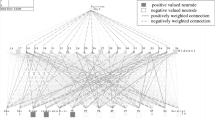Abstract
To determine whether an artificial neural network trained to recognize the presence of acute myocardial infarction makes clinical decisions based on nonlinear relationships it establishes between inputted information, a linear and nonlinear network with identical number of input nodes were trained and then tested on identical pattern sets. The ratio of residual variances between the two networks was 0.726. The linear and nonlinear networks made 21 and 9 errors, respectively, on 350 test patterns. The use of nonlinear relationships was further studied by trending the quantitative effect on network output resulting from the modification of single clinical input variables in 706 specific patterns derived from patients presenting with anterior chest pain. This revealed that the distribution of the effect on network output was bimodally distributed in 8 of the 20 clinical input variables utilized by the network. The basis for this distribution was due to the network placing markedly different diagnostic importance on the same variable in different patterns. This appears to be the first instance in which nonlinear logic has been shown to improve upon clinical decision-making.
Similar content being viewed by others
Explore related subjects
Discover the latest articles, news and stories from top researchers in related subjects.References
Hudson DL, Cohen ME, Anderson MF. Determination of testing efficacy in carcinoma of the lung using a neural network mode. In: Symposium on Computer Applications in Medical Care Proceedings: 12th Annual Symposium, Washington, DC, 1988; 12: 251–255
Smith JW, Everhart JE, Dickson WC, Knowler WC, Johannes RS. Using the ADAP learning algorithm to forecast the onset of diabetes mellitus. In: Symposium on Computer Applications in Medical Care Proceedings: 12th Annual Symposium, Washington, DC, 1988; 12: 261–265
Saito K, Nakano R. Medical diagnostic expert system based on PDP model. In: Proceedings of the International Joint Conference on Neural Networks, San Diego, CA, 1988; 2: 255–262
Kaufman JJ, Chiabera A, Hatem M, et al. A neural network approach for bone fracture healing assessment. IEEE Engineering in Medicine and Biology Magazine 1990; 9: 23–30
Hiraiwa A, Shimohara K, Tokunaga Y. EEG topography recognition by neural networks. IEEE Engineering in Medicine and Biology Magazine 1990; 9: 39–42
Cios KJ, Chen K, Langenderfer RA. Use of neural networks in detecting cardiac diseases from echocardiographic images. IEEE Engineering in Medicine and Biology Magazine 1990; 9: 58–60
Marconi L, Scalia F, Ridella S, Arrigo P, Mansi C, Mela GS. An application of back propagation to medical diagnosis. In: Proceedings of the International Joint Conference on Neural Networks, Washington, DC, 1989; 2: 577
Eberhart RC, Dobbins RW, Hutton LV. Neural network paradigm comparisons for appendicitis diagnoses. In: Proceedings of the Fourth Annual IEEE Symposium on Computer-Based Medical Systems, 1991; 298–304
Mulsant GH, Servan-Schreiber E. A connectionist approach to the diagnosis of dementia. In: Symposium on Computer Applications in Medical Care Proceedings: 12th Annual Symposium, Washington, DC, 1988; 12: 245–250
Bounds DG, Lloyd PJ, Mathew BG. A comparison of neural network and other pattern recognition approaches to the diagnosis of low back disorders. Neural Networks 1990; 3: 583–591
Yoon YO, Brobst RW, Bergstresser PR, Peterson LL: A desktop neural network for dermatology diagnosis. Journal of Neural Network Computation. Summer 1989; 43–52
Baxt WG. Use of an artificial neural network for data analysis in clinical decision-making: The diagnosis of acute coronary occlusion. Neural Computation 1990; 2: 480–489
Baxt WG. Use of an artificial neural network for the diagnosis of myocardial infarction. Ann Intern Med 1991; 115: 843–848
Baxt WG. Improving the accuracy of an artificial neural network using multiple differently trained networks. Neural Computation 1992; 4: 772–780
Harrison RF, Marshall SJ, Kennedy RL. The early diagnosis of heart attacks: A neurocomputational approach. In: Proceedings of the International Joint Conference on Neural Networks, Seattle, WA, 1991; 1: 1–5
Goldman L, Cook EF, Brand DA et al. A computer protocol to predict myocardial infarction in emergency department patients with chest pain. New England Journal of Medicine 1988; 318: 797–803
McClelland JL, Rumelhart DE. Training hidden units. In: McClelland JL, Rumelhart DE (eds). Explorations in parallel distributed processing. MIT Press, Cambridge, MA, 1988; 121–160
Weigend AS, Huberman BA, Rumelhart DE. Predicting the future: A connectionist approach. International Journal of Neural Systems 1990; 1: 193–209
Baxt WG. Analysis of the clinical variables driving decision in an artificial neural network trained to identify the presence of myocardial infarction. Annals of Emergency Medicine 1992; 21: 1439–1444
Ryback RS, Eckardt MJ, Felsher B, Rawlings RR. Biochemical and hematologic correlates of alcoholism and liver disease. JAMA 1982; 248: 2261–2265
Ryback RS, Eckardt MJ, Rawlings RR, Rosenthal LS. Quadratic discriminant analysis as an aid to interpretive reporting of clinical laboratory tests. JAMA 1982; 248: 2342–2345
Baxt WG, Berry CC, Epperson MD, Scalzitti V. The failure of prehospital trauma prediction rules to classify trauma patients accurately. Annals of Emergency Medicine 1989; 18: 1–8
Author information
Authors and Affiliations
Rights and permissions
About this article
Cite this article
Baxt, W.G. A neural network trained to identify the presence of myocardial infarction bases diagnostic decision on nonlinear relationships between input variables. Neural Comput & Applic 1, 176–182 (1993). https://doi.org/10.1007/BF01414944
Received:
Issue Date:
DOI: https://doi.org/10.1007/BF01414944




